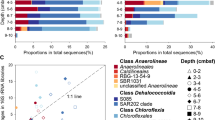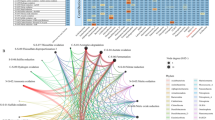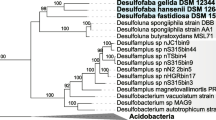Abstract
Ecological studies on marine microbial communities largely focus on fundamental biogeochemical processes or the most abundant constituents, while minor biological fractions are frequently neglected. Youngimonas vesicularis CC-AMW-ET, isolated from coastal surface seawater in Taiwan, is an under-represented marine Paracoccaceae (earlier Rhodobacteraceae) member. The CC-AMW-ET genome was sequenced to gain deeper insights into its role in marine carbon and sulfur cycles. The draft genome (3.7 Mb) contained 63.6% GC, 3773 coding sequences and 51 RNAs, and displayed maximum relatedness (79.06%) to Thalassobius litoralis KU5D5T, a Roseobacteraceae member. While phototrophic genes were absent, genes encoding two distinct subunits of carbon monoxide dehydrogenases (CoxL, BMS/Form II and a novel form III; CoxM and CoxS), and proteins involved in HCO3− uptake and interconversion, and anaplerotic HCO3− fixation were found. In addition, a gene coding for ribulose-1,5-bisphosphate carboxylase/oxygenase (RuBisCO, form II), which fixes atmospheric CO2 was found in CC-AMW-ET. Genes for complete assimilatory sulfate reduction, sulfide oxidation (sulfide:quinone oxidoreductase, SqrA type) and dimethylsulfoniopropionate (DMSP) cleavage (DMSP lyase, DddL) were also identified. Furthermore, genes that degrade aromatic hydrocarbons such as quinate, salicylate, salicylate ester, p-hydroxybenzoate, catechol, gentisate, homogentisate, protocatechuate, 4-hydroxyphenylacetic acid, N-heterocyclic aromatic compounds and aromatic amines were present. Thus, Youngimonas vesicularis CC-AMW-ET is a potential chemolithoautotroph equipped with genetic machinery for the metabolism of aromatics, and predicted to play crucial roles in the biogeochemical cycling of marine carbon and sulfur.






Similar content being viewed by others
Data availability
This whole-genome shotgun project for Youngimonas vesicularis CC-AMW-ET has been deposited at DDBJ/ENA/GenBank under BioProject no. PRJNA531816, and the accession no. is SSMD00000000. The version described in this paper is the first version.
References
Albuquerque L, Santos J, Travassos P, Nobre MF, Rainey FA, Wait R, Empadinhas N, Silva MT, da Costa MS (2002) Albidovulum inexpectatum gen. nov., sp. nov., a nonphotosynthetic and slightly thermophilic bacterium from a marine hot spring that is very closely related to members of the photosynthetic genus Rhodovulum. Appl Environ Microbiol 68:4266–4273. https://doi.org/10.1128/AEM.68.9.4266-4273.2002
Aziz RK, Bartels D, Best AA, DeJongh M, Disz T, Edwards RA, Formsma K, Gerdes S, Glass EM, Kubal M, Meyer F, Olsen GJ, Olson R, Osterman AL, Overbeek RA, McNeil LK, Paarmann D, Paczian T, Parrello B, Pusch GD, Reich C, Stevens R, Vassieva O, Vonstein V, Wilke A, Zagnitko O (2008) The RAST server: rapid annotations using subsystems technology. BMC Genomics 9:75. https://doi.org/10.1186/1471-2164-9-75
Bankevich A, Nurk S, Antipov D, Gurevich AA, Dvorkin M, Kulikov AS, Lesin VM, Nikolenko SI, Pham S, Prjibelski AD, Pyshkin AV, Sirotkin AV, Vyahhi N, Tesler G, Alekseyev MA, Pevzner PA (2012) SPAdes: a new genome assembly algorithm and its applications to single-cell sequencing. J Comput Biol 19:455–477. https://doi.org/10.1089/cmb.2012.0021
Barbeyron T, Brillet-Guéguen L, Carré W, Carrière C, Caron C, Czjzek M, Hoebeke M, Michel G (2016) Matching the diversity of sulfated biomolecules: creation of a classification database for sulfatases reflecting their substrate specificity. PLoS One 11:e0164846. https://doi.org/10.1371/journal.pone.0164846
Bolger AM, Lohse M, Usadel B (2014) Trimmomatic: a flexible trimmer for Illumina sequence data. Bioinformatics 30:2114–2120. https://doi.org/10.1093/bioinformatics/btu170
Bronstein M, Schütz M, Hauska G, Padan E, Shahak Y (2000) Cyanobacterial sulfide-quinone reductase: cloning and heterologous expression. J Bacteriol 182:3336–3344. https://doi.org/10.1128/jb.182.12.3336-3344.2000
Chan LK, Morgan-Kiss RM, Hanson TE (2009) Functional analysis of three sulfide:quinone oxidoreductase homologs in Chlorobaculum tepidum. J Bacteriol 191:1026–1034. https://doi.org/10.1128/JB.01154-08
Cunliffe M (2011) Correlating carbon monoxide oxidation with cox genes in the abundant Marine Roseobacter Clade. The ISME J 5(4):685–691. https://doi.org/10.1038/ismej.2010.170
Curson AR, Rogers R, Todd JD, Brearley CA, Johnston AW (2008) Molecular genetic analysis of a dimethylsulfoniopropionate lyase that liberates the climate-changing gas dimethylsulfide in several marine alpha-proteobacteria and Rhodobacter sphaeroides. Environ Microbiol 10:757–767. https://doi.org/10.1111/j.1462-2920.2007.01499.x
Eddy SR (2011) Accelerated profile HMM searches. PLoS Comput Biol 7:e10002195. https://doi.org/10.1371/journal.pcbi.1002195
González JM, Kiene RP, Moran MA (1999) Transformation of sulfur compounds by an abundant lineage of marine bacteria in the alpha-subclass of the class Proteobacteria. Appl Environ Microbiol 65:3810–3819. https://doi.org/10.1128/AEM.65.9.3810-3819.1999
González JM, Fernández-Gómez B, Fernàndez-Guerra A, Gómez-Consarnau L, Sánchez O, Coll-Lladó M, Del Campo J, Escudero L, Rodríguez-Martínez R, Alonso-Sáez L, Latasa M, Paulsen I, Nedashkovskaya O, Lekunberri I, Pinhassi J, Pedrós-Alió C (2008) Genome analysis of the proteorhodopsin-containing marine bacterium Polaribacter sp. MED152 (Flavobacteria). Proc Natl Acad Sci U S A 105:8724–8729. https://doi.org/10.1073/pnas.0712027105
Grant JR, Enns E, Marinier E, Mandal A, Herman EK, Chen CY, Graham M, Van Domselaar G, Stothard P (2023) Proksee: in-depth characterization and visualization of bacterial genomes. Nucleic Acids Res. https://doi.org/10.1093/nar/gkad326
Gregersen LH, Bryant DA, Frigaard NU (2011) Mechanisms and evolution of oxidative sulfur metabolism in green sulfur bacteria. Front Microbiol 2:116. https://doi.org/10.3389/fmicb.2011.00116
Guilloton MB, Korte JJ, Lamblin AF, Fuchs JA, Anderson PM (1992) Carbonic anhydrase in Escherichia coli. A product of the cyn operon. J Biol Chem 267:3731–3734. https://doi.org/10.1016/S0021-9258(19)50586-5
Hameed A, Shahina M, Lin SY, Nakayan P, Liu YC, Lai WA, Hsu YH (2014) Youngimonas vesicularis gen. nov., sp nov., of the family Rhodobacteraceae, isolated from surface seawater, reclassification of Donghicola xiamenensis Tan et al. 2009 as Pseudodonghicola xiamenensis gen. nov., comb. nov and emended description of the genus Donghicola Yoon et al. 2007. Int J Syst Evol Microbiol 64:2729–2737. https://doi.org/10.1099/ijs.0.060962-0
Hameed A, Shahina M, Huang HC, Lai WA, Lin SY, Stothard P, Young CC (2018) Complete genome sequence of Siansivirga zeaxanthinifaciens CC-SAMT-1T, a flavobacterium isolated from coastal surface seawater. Mar Genomics 37:21–25. https://doi.org/10.1016/j.margen.2017.09.003
Hameed A, Lai WA, Shahina M, Stothard P, Young LS, Lin SY, Sridhar KR, Young CC (2020) Differential visible spectral influence on carbon metabolism in heterotrophic marine flavobacteria. FEMS Microbiol Ecol. https://doi.org/10.1093/femsec/fiaa011
Hameed A, Shahina M, Lin SY, Chen WM, Hsu YH, Lai WA, Young CC (2020) Description of Gemmobacter aestuarii sp. nov., isolated from estuarine surface water and reclassification of Cereibacter changlensis as Gemmobacter changlensis Chen et al. 2013. Arch Microbiol 202:1035–1042. https://doi.org/10.1007/s00203-020-01809-y
Helsel LO, Hollis D, Steigerwalt AG, Morey RE, Jordan J, Aye T, Radosevic J, Jannat-Khah D, Thiry D, Lonsway DR, Patel JB, Daneshvar MI, Levette PN (2007) Identification of Haematobacter, a new genus of aerobic Gram-negative rods isolated from clinical specimens, and reclassification of Rhodobacter massiliensis as Haematobacter massiliensis comb. nov. J Clin Microbiol 45:1238–1243. https://doi.org/10.1128/jcm.01188-06
Hördt A, López MG, Meier-Kolthoff JP, Schleuning M, Weinhold LM, Tindall BJ, Gronow S, Kyrpides NC, Woyke T, Göker M (2020) Analysis of 1,000+ Type-Strain Genomes Substantially Improves Taxonomic Classification of Alphaproteobacteria. Front Microbiol 11:468. https://doi.org/10.3389/fmicb.2020.00468
Hu Q, Zhang L, Hang P, Zhou XY, Jia WB, Li SP, Jiang JD (2018) Xinfangfangia soli gen. nov., sp. nov., isolated from a diuron-polluted soil. Int J Syst Evol Microbiol 68:2622–2626. https://doi.org/10.1099/ijsem.0.002887
Hyatt D, Chen GL, Locascio PF, Land ML, Larimer FW, Hauser LJ (2010) Prodigal: prokaryotic gene recognition and translation initiation site identification. BMC Bioinformatics 11:119. https://doi.org/10.1186/1471-2105-11-119
Iwaki H, Yasukawa N, Fujioka M, Takada K, Hasegawa Y (2013) Isolation and characterization of a marine cyclohexylacetate-degrading bacterium Lutimaribacter litoralis sp. nov., and reclassification of Oceanicola pacificus as Lutimaribacter pacificus comb. nov. Curr Microbiol 66:588–593. https://doi.org/10.1007/s00284-013-0321-x
Katoh K, Standley DM (2013) MAFFT Multiple sequence alignment software version 7: improvements in performance and usability. Mol Biol Evol 30:772–780. https://doi.org/10.1093/molbev/mst010
Kim YO, Noh JK, Kim DG, Park IS, Park S, Yoon JH (2021) Paenihalocynthiibacter styelae gen. nov., sp. nov., isolated from stalked sea squirt Styela clava. Int J Syst Evol Microbiol. https://doi.org/10.1099/ijsem.0.005085
King GM (2003) Molecular and culture-based analyses of aerobic carbon monoxide oxidizer diversity. Appl Environ Microbiol 69:7257–7265. https://doi.org/10.1128/aem.69.12.7257-7265.2003
King GM, Weber CF (2007) Distribution, diversity and ecology of aerobic CO-oxidizing bacteria. Nat Rev Microbiol 5:107–118. https://doi.org/10.1038/nrmicro1595
Kong YH, Ren WT, Xu L, Cheng H, Zhou P, Wang CS, Wu YH, Xu XW (2022) Mesobacterium pallidum gen. nov., sp. nov., Heliomarina baculiformis gen. nov., sp. nov. and Oricola indica sp. nov., three novel Alphaproteobacteria members isolated from deep-sea water in the southwest Indian ridge. Int J Syst Evol Microbiol. https://doi.org/10.1099/ijsem.0.005236
Labrenz M, Lawson PA, Tindall BJ, Hirsch P (2009) Roseibaca ekhonensis gen. nov., sp. nov., an alkalitolerant and aerobic bacteriochlorophyll a-producing alphaproteobacterium from hypersaline Ekho Lake. Int J Syst Evol Microbiol 59:1935–1940. https://doi.org/10.1099/ijs.0.016717-0
Lee I, Ouk Kim Y, Park SC, Chun J (2016) OrthoANI: an improved algorithm and software for calculating average nucleotide identity. Int J Syst Evol Microbiol 66:1100–1103. https://doi.org/10.1099/ijsem.0.000760
Li AH, Zhou YG (2015) Frigidibacter albus gen. nov., sp. nov., a novel member of the family Rhodobacteraceae isolated from lake water. Int J Syst Evol Microbiol 65:1199–1206. https://doi.org/10.1099/ijs.0.000080
Liang KYH, Orata FD, Boucher YF, Case RJ (2021) Roseobacters in a Sea of Poly- and Paraphyly: Whole Genome-Based Taxonomy of the Family Rhodobacteraceae and the Proposal for the Split of the Roseobacter Clade Into a Novel Family Roseobacteraceae fam. nov. Front Microbiol 12:683109. https://doi.org/10.3389/fmicb.2021.683109
Lim JM, Jeon CO, Jang HH, Park DJ, Shin YK, Yeo SH, Kim CJ (2008) Albimonas donghaensis gen. nov., sp. nov., a non-photosynthetic member of the class Alphaproteobacteria isolated from seawater. Int J Syst Evol Microbiol 58:282–285. https://doi.org/10.1099/ijs.0.65429-0
Marcia M, Ermler U, Peng G, Michel H (2009) The structure of Aquifex aeolicus sulfide:quinone oxidoreductase, a basis to understand sulfide detoxification and respiration. Proc Natl Acad Sci U S A 106:9625–9630. https://doi.org/10.1073/pnas.09041651064
Milford AD, Achenbach LA, Jung DO, Madigan MT (2000) Rhodobaca bogoriensis gen. nov. and sp. nov., an alkaliphilic purple nonsulfur bacterium from African Rift Valley soda lakes. Arch Microbiol 174:18–27. https://doi.org/10.1007/s002030000166
Moran MA, Buchan A, González JM, Heidelberg JF, Whitman WB, Kiene RP, Henriksen JR, King GM, Belas R, Fuqua C, Brinkac L, Lewis M, Johri S, Weaver B, Pai G, Eisen JA, Rahe E, Sheldon WM, Ye WY, Miller TR, Carlton J, Rasko DA, Paulsen IT, Ren QH, Daugherty SC, Deboy RT, Dodson RJ, Durkin AS, Madupu R, Nelson WC, Sullivan SA, Rosovitz MJ, Haft DH, Selengut J, Ward N (2004) Genome sequence of Silicibacter pomeroyi reveals adaptations to the marine environment. Nature 432:910–913. https://doi.org/10.1038/nature03170
Moran MA, Belas R, Schell MA, González JM, Sun F, Sun S, Binder BJ, Edmonds J, Ye W, Orcutt B, Howard EC, Meile C, Palefsky W, Goesmann A, Ren Q, Paulsen I, Ulrich LE, Thompson LS, Saunders E, Buchan A (2007) Ecological genomics of marine roseobacters. Appl Environ Microbiol 73:4559–4569. https://doi.org/10.1128/Aem.02580-06
Murray RGE, Doetsch RN, Robinow CF (1994) Determinative and cytological light microscopy. In: Gerhardt P, Murray RGE, Wood WA, Krieg NR (eds) Methods for General and Molecular Bacteriology. American Society for Microbiology, Washington, DC, pp 21–41
Na SI, Kim YO, Yoon SH, Ha SM, Baek I, Chun J (2018) UBCG: Up-to-date bacterial core gene set and pipeline for phylogenomic tree reconstruction. J Microbiol 56:280–285. https://doi.org/10.1007/s12275-018-8014-6
Newton RJ, Griffin LE, Bowles KM, Meile C, Gifford S, Givens CE, Howard EC, King E, Oakley CA, Reisch CR, Rinta-Kanto JM, Sharma S, Sun SL, Varaljay V, Vila-Costa M, Westrich JR, Moran MA (2010) Genome characteristics of a generalist marine bacterial lineage. ISME J 4:784–798. https://doi.org/10.1038/ismej.2009.150
Nübel T, Klughammer C, Huber R, Hauska G, Schütz M (2000) Sulfide:quinone oxidoreductase in membranes of the hyperthermophilic bacterium Aquifex aeolicus (VF5). Arch Microbiol 173:233–244. https://doi.org/10.1007/s002030000135
Parte AC, Sardà Carbasse J, Meier-Kolthoff JP, Reimer LC, Göker M (2020) List of Prokaryotic names with Standing in Nomenclature (LPSN) moves to the DSMZ. Int J Syst Evol Microbiol 70:5607–5612. https://doi.org/10.1099/ijsem.0.004332
Pohlner M, Dlugosch L, Wemheuer B, Mills H, Engelen B, Reese BK (2019) The majority of active Rhodobacteraceae in marine sediments belong to uncultured genera: a molecular approach to link their distribution to environmental conditions. Front Microbiol 10:659. https://doi.org/10.3389/fmicb.2019.00659
Price GD, Woodger FJ, Badger MR, Howitt SM, Tucker L (2004) Identification of a SulP-type bicarbonate transporter in marine cyanobacteria. Proc Natl Acad Sci U S A 101:18228–18233. https://doi.org/10.1073/pnas.0405211101
Price MN, Dehal PS, Arkin AP (2010) FastTree 2–approximately maximum-likelihood trees for large alignments. PLoS One 5:e9490. https://doi.org/10.1371/journal.pone.0009490
Quiza L, Lalonde I, Guertin C, Constant P (2014) Land-use influences the distribution and activity of high affinity CO-oxidizing bacteria associated to type l-coxL genotype in soil. Front Microbiol. https://doi.org/10.3389/Fmicb.2014.00271
Rekha PD, Shastry RP, Hameed A, Ghate SD, Arun AB, Athmika N (2023) Genomic potential for exopolysaccharide production and differential polysaccharide degradation in closely related Alteromonas sp. PRIM-21 and Alteromonas fortis 1T. Antonie Van Leeuwenhoek 116:39–51. https://doi.org/10.1007/s10482-022-01796-8
Robertson LA, Kuenen JG (1983) Thiosphaera pantotropha gen. nov., sp. nov., a facultatively anaerobic, facultatively autotrophic sulphur bacterium. J Gen Microbiol 129:2847–2855. https://doi.org/10.1099/00221287-129-9-2847
Rodriguez-R LM, Konstantinidis KT (2016) The enveomics collection: a toolbox for specialized analyses of microbial genomes and metagenomes. PeerJ Preprints 4:e1900v1. https://doi.org/10.7287/peerj.preprints.1900v1
Romanenko LA, Kurilenko VV, Chernysheva NY, Tekutyeva LA, Velansky PV, Svetashev VI, Isaeva MP (2021) Harenicola maris gen. nov., sp. nov. isolated from the Sea of Japan shallow sediments. Arch Microbiol 203:3973–3979. https://doi.org/10.1007/s00203-021-02360-0
Schütz M, Maldener I, Griesbeck C, Hauska G (1999) Sulfide-quinone reductase from Rhodobacter capsulatus: requirement for growth, periplasmic localization, and extension of gene sequence analysis. J Bacteriol 181:6516–6523. https://doi.org/10.1128/JB.181.20.6516-6523.1999
Shibata M, Katoh H, Sonoda M, Ohkawa H, Shimoyama M, Fukuzawa H, Kaplan A, Ogawa T (2002) Genes essential to sodium-dependent bicarbonate transport in cyanobacteria - Function and phylogenetic analysis. J Biol Chem 277:18658–18664. https://doi.org/10.1074/jbc.M112468200
Sorokin DY (2003) Oxidation of inorganic sulfur compounds by obligately organotrophic bacteria. Microbiology 72:641–653. https://doi.org/10.1023/B:Mici.0000008363.24128.E5
Sorokin DY, Tourova TP, Kuznetsov BB, Briantseva IA, Gorlenko VM (2000) Roseinatronobacter thiooxidans gen. nov., sp. nov., a new alkaliphilic aerobic bacteriochlorophyll-alpha-containing bacteria from a soda lake. Mikrobiologiia 69:89–97. https://doi.org/10.1007/BF02757261
Sorokin DY, Tourova TP, Spiridonova EM, Rainey FA, Muyzer G (2005) Thioclava pacifica gen. nov., sp. nov., a novel facultatively autotrophic, marine, sulfur-oxidizing bacterium from a near-shore sulfidic hydrothermal area. Int J Syst Evol Microbiol 55:1069–1075. https://doi.org/10.1099/ijs.0.63415-0
Stamatakis A (2014) RAxML version 8: a tool for phylogenetic analysis and post-analysis of large phylogenies. Bioinformatics 30:1312–1313. https://doi.org/10.1093/bioinformatics/btu033
Subhash Y, Tushar L, Sasikala Ch (2013) Falsirhodobacter halotolerans gen. nov., sp. nov., isolated from dry soils of a solar saltern. Int J Syst Evol Microbiol 63:2132–2137. https://doi.org/10.1099/ijs.0.044107-0
Sun H, Zheng H, Liao B, Chen B, Li A, Xiao B (2022) Algiphilus acroporae sp. nov. and Coraliihabitans acroporae gen. nov. sp. nov., isolated from scleractinian coral Acropora digitifera. Int J Syst Evol Microbiol 272:5321. https://doi.org/10.1099/ijsem.0.005321
Swan BK, Martinez-Garcia M, Preston CM, Sczyrba A, Woyke T, Lamy D, Reinthaler T, Poulton NJ, Masland EDP, Gomez ML, Sieracki ME, DeLong EF, Herndl GJ, Stepanauskas R (2011) Potential for chemolithoautotrophy among ubiquitous bacteria lineages in the dark ocean. Science 333:1296–1300. https://doi.org/10.1126/science.1203690
Tabita FR, Satagopan S, Hanson TE, Kreel NE, Scott SS (2008) Distinct form I, II, III, and IV Rubisco proteins from the three kingdoms of life provide clues about Rubisco evolution and structure/function relationships. J Exp Bot 59:1515‒24. https://doi.org/10.1093/jxb/erm361
Uchino Y, Yokota A (2003) “Green-like” and “red-like” RubisCO cbbL genes in Rhodobacter azotoformans. Mol Biol Evol 20:821–830. https://doi.org/10.1093/molbev/msg100
UniProt C (2023) UniProt: the universal protein knowledgebase in 2023. Nucleic Acids Res 51:D523–D531. https://doi.org/10.1093/nar/gkac1052
Wang S, Yang R, Xu L, Xing YT, Sun JQ (2019) Qingshengfaniella alkalisoli gen. nov., sp. nov., a p-hydroxybenzoate-degrading strain isolated from saline soil. Int J Syst Evol Microbiol. https://doi.org/10.1099/ijsem.0.004719
Wei TT, Fan XB, Quan ZX (2023) Abyssibius alkaniclasticus gen. nov., sp. nov., a novel member of the family Rhodobacteraceae, isolated from the Mariana Trench. Int J Syst Evol Microbiol 73:5715. https://doi.org/10.1099/ijsem.0.005715
Xu L, Liu A, Zhang YJ (2021) Zongyanglinia huanghaiensis gen. nov., sp. nov., a novel denitrifying bacterium isolated from the yellow sea, and transfer of Pelagicola marinus to Zongyanglinia gen. nov. as Zongyanglinia marinus comb. nov. Antonie Van Leeuwenhoek 114:137–149. https://doi.org/10.1007/s10482-020-01507-1
Yin D, Chen L, Ao J, Ai C, Chen X (2013) Pleomorphobacterium xiamenense gen. nov., sp. nov., a moderate thermophile isolated from a terrestrial hot spring. Int J Syst Evol Microbiol 63:1868–1873. https://doi.org/10.1099/ijs.0.042713-0
Zhang H, Yohe T, Huang L, Entwistle S, Wu P, Yang Z, Busk PK, Xu Y, Yin Y (2018) dbCAN2: a meta server for automated carbohydrate-active enzyme annotation. Nucleic Acids Res 46:W95–W101. https://doi.org/10.1093/nar/gky418
Acknowledgements
Authors would like to thank Yu-Ting Hseih for her technical assistance.
Funding
This work was financially supported by the National Science and Technology Council (Taiwan) under Grant No. 111–2313-B-005–050 and by the “Innovation and Development Center of Sustainable Agriculture” from The Featured Areas Research Center Program within the framework of the Higher Education Sprout Project by the Ministry of Education (MOE) in Taiwan.
Author information
Authors and Affiliations
Contributions
CCY and AH conceptualized the work. AH drafted the manuscript. AH, SKV and PS performed genomic data mining, annotation and comparative genomics. AH analyzed the data and restructured the manuscript with scientific input from all the authors. SYL performed AAI, UBCG and microscopic analysis. All the authors discussed the results and revised the manuscript.
Corresponding authors
Ethics declarations
Competing interests
The authors declare no competing interests.
Conflict of interest
The authors declare no competing interests.
Ethical approval
None.
Informed consent
None.
Additional information
Publisher's Note
Springer Nature remains neutral with regard to jurisdictional claims in published maps and institutional affiliations.
Supplementary Information
Below is the link to the electronic supplementary material.
Rights and permissions
Springer Nature or its licensor (e.g. a society or other partner) holds exclusive rights to this article under a publishing agreement with the author(s) or other rightsholder(s); author self-archiving of the accepted manuscript version of this article is solely governed by the terms of such publishing agreement and applicable law.
About this article
Cite this article
Hameed, A., Suchithra, K.V., Lin, SY. et al. Genomic potential for inorganic carbon sequestration and xenobiotic degradation in marine bacterium Youngimonas vesicularis CC-AMW-ET affiliated to family Paracoccaceae. Antonie van Leeuwenhoek 116, 1247–1259 (2023). https://doi.org/10.1007/s10482-023-01881-6
Received:
Accepted:
Published:
Issue Date:
DOI: https://doi.org/10.1007/s10482-023-01881-6




